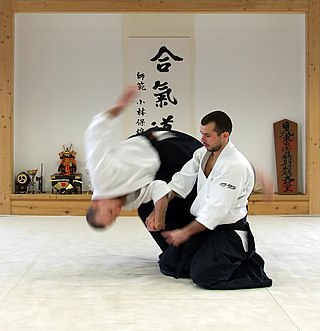
Aikido is a modern Japanese martial art which is split into many different styles including Iwama Ryu, Iwama Shin Shin Aiki Shuren Kai, Shodokan Aikido, Yoshinkan, Renshinkai, Aikikai, and Ki Aikido. Aikido is now practiced in around 140 countries. It was originally developed by Morihei Ueshiba, as a synthesis of his martial studies, philosophy and religious beliefs. Ueshiba's goal was to create an art which practitioners could use to defend themselves while also protecting their attackers from injury. Aikido is often translated as "the way of unifying (with) life energy" or as "the way of harmonious spirit". According to the founder's philosophy, the primary goal in the practice of aikido is to overcome oneself instead of cultivating violence or aggressiveness. Morihei Ueshiba used the phrase masakatsu agatsu katsuhayabi" to refer to this principle.
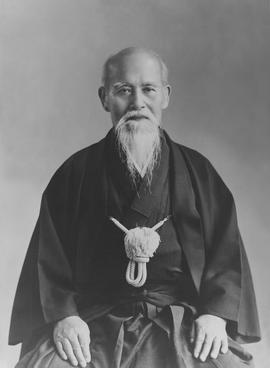
Morihei Ueshiba was a Japanese martial artist and founder of the martial art of aikido. He is often referred to as "the founder" Kaiso (開祖) or Ōsensei (大先生/翁先生), "Great Teacher".
The Ki Society is an aikido organization founded by Koichi Tohei in 1971, while he was the chief instructor at the Aikikai Hombu Dojo. The official Japanese name of the organization is Shin Shin Toitsu Aikido Kai (心身統一合気道会), but it is also known in English-speaking countries as "Ki Society". Its foundation reflected Tohei's differences with the Aikikai, and his own emphasis on developing the concept of Ki. Students of the art are graded in Ki and Aikido classes. Tohei's Ki lessons come from Shin Shin Tōitsu-dō (心身統一道), meaning "the way of realizing the [original] unity of mind and body". The martial discipline of the art is frequently referred to as Ki-Aikido, particularly in the Western world.
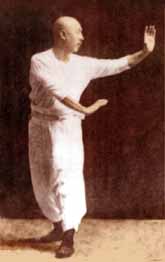
Baguazhang is one of the three main Chinese martial arts of the Wudang school, the other two being tai chi and xingyiquan. It is more broadly grouped as an internal practice. Baguazhang literally means "eight trigram palm", referring to the bagua "trigrams" of the I Ching, one of the canons of Taoism.
Andrew Harvey is a British author, religious scholar and teacher of mystic traditions, known primarily for his popular nonfiction books on spiritual or mystical themes, beginning with his 1983 A Journey in Ladakh. He is the author of over 30 books, including, The Hope, A Guide to Sacred Activism, The Direct Path, the critically acclaimed Way of Passion: A Celebration of Rumi, The Return of the Mother and Son of Man. He was the subject of the 1993 BBC documentary "The Making of a Modern Mystic" and is the founder of the Sacred Activism movement.
Robert Nadeau is an American aikido teacher holding the rank of 8th dan and master teacher(Shihan) in the Aikikai. He is well known as a pioneer in the energy and awareness aspects of aikido, having dedicated his life's work to understanding and translating these principles handed down by Ueshiba into fields beyond aikido, including psychotherapy, personal development. Nadeau began training in martial arts at the age of 16 and began studying Aikido with American instructor Robert Tan. After Training in Japan with the founder of Aikido, Morihei Ueshiba, from 1962-1964 Nadeau returned to Northern California and opened a series of martial art schools sharing space with first Professor Sig Kuferat and later Richard Bunch through whom he has had on-going contact with several notable Ju-Jitsu schools and which eventually led to the formation of the California Aikido Association. He is one of three division heads of the California Aikido Association and is also the founder and head instructor of City Aikido of San Francisco, Aikido of San Jose, and Aikido of Mountain View, CA. Nadeau has taught workshops in the United States, Switzerland, Israel and New Zealand.

Jūkendō (銃剣道) is the Japanese martial art of bayonet fighting, and has been likened to kendo.
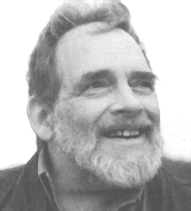
Terry Dobson birthname Walter Norton Dobson III (1937–1992) was an American aikido pioneer, aikido teacher, and writer, who studied directly with the founder of aikido, Morihei Ueshiba, as one of the first, small handful of non-Japanese to do so.
Jeanne Rose was an herbalist and aromatherapist who changed the practice of American herbalism when she began her public work in 1969 with the publication of her first book, Herbs & Things: Jeanne Rose's Herbal. She began her herbal career in California as an undergraduate with studies in botany and science and a degree from San Jose State College. She went on to graduate work in marine biology and ecology. In 1969, she wrote the first modern book of herbalism, Herbs & Things. She taught herbs and aromatherapy at the University of California Extension throughout the 1970s and privately throughout the United States. She has lived in San Francisco since 1967 and established a herbal/aromatic garden and study center. Becoming concerned about the environment and the production of aromatic plants, she organized the aromatherapy industry and a group, The Aromatic Plant Project, to support local and organic production of aromatic plants, to provide resources for growers and distillers, to ensure high quality aromatherapy products and to educate consumers as to the appropriate and beneficial uses of these aromatic products.

Bruce Kumar Frantzis is a Taoist educator who studied Taoism in China.
Richard Grossinger is an American writer and founder of North Atlantic Books in Berkeley, California.
George Burr Leonard was an American writer, editor, and educator who wrote extensively about education and human potential. He served as President Emeritus of the Esalen Institute, past-president of the Association for Humanistic Psychology, co-founder of Integral Transformative Practice International, and an editor of Look Magazine. He was a United States Army Air Corps pilot, and held a fifth-degree black belt in aikido. Typical of his philosophy, life's work, and the times (1960s), Leonard stated: "Western civilization has been a 2,000 year long exercise in robbing people of the present. People are now learning the powerful joys that hide in the narrow place of the hourglass, the eternal moment. Here is their golden learning: to see - really see - spring flowers; to feel - really feel - the grace of love."
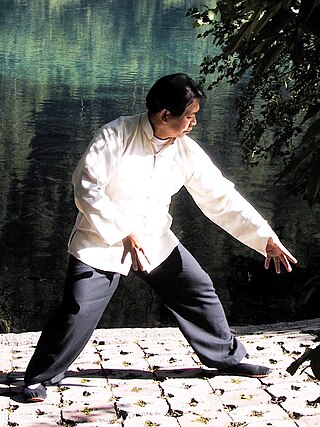
Qigong is a system of coordinated body-posture and movement, breathing, and meditation said to be useful for the purposes of health, spirituality, and martial arts training. With roots in Chinese medicine, philosophy, and martial arts, qigong is traditionally viewed by the Chinese and throughout Asia as a practice to cultivate and balance the mythical life-force qi.
Geoffrey Robert Gleeson (1927–1994) was a British judoka. Teacher: Trevor Leggett. He went to Japan 1952-55 where he and Charles Palmer were the first westerners to serve as a special research students at the Kodokan Judo Institute. He studied most martial arts: Judo, Kendo, Aikido, Bōjutsu, Jujitsu, Karate, and also studied Zen Buddhism. First kenshusei post World War II. Posthumously awarded 9th Dan.
Strozzi Institute is an organization located in Oakland, California that offers coaching services and trainings in leadership, organizational development, and personal mastery. It uses a somatic approach to learning. Programs are offered primarily at the institute's Sonoma training center.
Hiroshi Kato; was an Aikido Master. He lived in Tokyo, Japan, and travelled the world teaching the principles of Aikido. A former student of Morihei Ueshiba, Sensei Kato taught from 1986 onwards in his Dojo "Suginami Aikikai" located in the Ogikubo district of Tokyo and has over 55 students.

Aikido and the Dynamic Sphere is a 1973 nonfiction book about the martial art of aikido.

Wang Shujin (1904–1981), also known as Wang Heng Sun, was a Chinese martial artist, practitioner of the disciplines of baguazhang, taijiquan, and xingyiquan. He was one of their greatest promoters outside China, being their first teacher in Taiwan and Japan, and was particularly known for his challenges to other martial artists. Aside from his martial exploits, Wang was also a spiritual leader in the Taoist sect Yiguandao.

Somatics is a field within bodywork and movement studies which emphasizes internal physical perception and experience. The term is used in movement therapy to signify approaches based on the soma, or "the body as perceived from within", including Skinner Releasing Technique, Alexander technique, the Feldenkrais Method, Eutony, Rolfing Structural Integration, among others. In dance, the term refers to techniques based on the dancer's internal sensation, in contrast with "performative techniques", such as ballet or modern dance, which emphasize the external observation of movement by an audience. Somatic techniques may be used in bodywork, psychotherapy, dance, or spiritual practices.
Thomas Louis Hanna was a philosophy professor and movement theorist who coined the term somatics in 1976. He called his work Hanna Somatic Education. He proposed that most negative health effects are due to what he called Sensory Motor Amnesia. He claimed that many common age-related ailments are not simply a matter of time but the result of poor movement habits.










